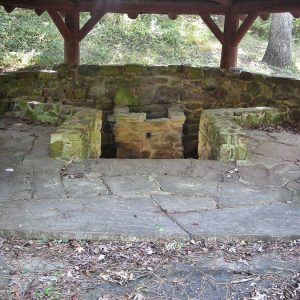calsfoundation@cals.org
Boyle Park
Boyle Park was created when John F. Boyle (1874–1938) donated a 231-acre tract of land in the southwestern area of the city to the City of Little Rock in 1929. The park was later expanded to include 243 acres. The park begins at 26th Street and Boyle Park Road, and Rock Creek runs through the park. In the deed, Boyle stipulated that the land was to be allocated for recreational use. If the property ever ceased to be used as a park, the title of the land would revert back to the Boyle family. Boyle Park was the third of its kind in the city. It was preceded by MacArthur Park in downtown Little Rock (Pulaski County) and Allsopp Park near midtown Little Rock.
Until the mid-1930s, no permanent development began on the site. In 1933, the Civilian Conservation Corps (CCC) Company 3777, under the direction of the National Park Service, created the Boyle Park project to help develop the land for the city’s recreational use. Rustic-style buildings using native stone were constructed by a local workforce. Similar building methods were undertaken at the Little Rock Zoo and in War Memorial Park and Union Park. The stone was brought in from Bear Den Mountain northwest of Little Rock. Five buildings were constructed in 1937: two pavilions, a spring house, a caretaker’s cabin, and a combination water tower/pump house/garage. Two culverts and a low-water bridge were also completed that year. Signs were also created for the park by the CCC in collaboration with a blacksmith.
Flooding from Rock Creek has occasionally threatened the park and surrounding neighborhoods. In 1944, the city introduced a flood-control plan that proposed the removal of groves of longstanding trees and vegetation for the creation of a flood channel between Rock Creek and nearby Fourche Creek, but nothing came of it. The channel was much debated between the late 1970s and early 1980s when floods in the area damaged large swaths of residential property and killed eight people. The city proposed this flood-control plan again in the 1980s, but in 1982 the proposal was rejected by the National Park Service, and the channel was never constructed.
Since the 1980s, the primary concerns revolving around Boyle Park have been related to upkeep of the historic structures on site as well as preventing crime within the park. The last major effort to rehabilitate the structures within the park was completed in 1994 after a bond issue allowed for funding. At the time, the Parks and Recreation department stated that the work would be all of the improvement available for Boyle Park for the foreseeable future. In the twenty-first century, the park is primarily used by Little Rock’s residents as a place to bike and hike within the city. It was listed on the National Register of Historic Places on September 22, 1995.
For additional information:
Boyle Park. City of Little Rock. https://www.littlerock.gov/!userfiles/editor/docs/planning/hdc/boyle_park_website_entry_021710_red1.pdf (accessed May 11, 2017).
“Boyle Park.” National Register of Historic Places nomination form. On file at the Arkansas Historic Preservation Program, Little Rock, Arkansas. Online at http://www.arkansaspreservation.com/National-Register-Listings/PDF/PU9773.nr.pdf (accessed May 11, 2017).
Dean, Jerry. “What Will Be the Fate of LRs Boyle Park?” Arkansas Gazette, May 26, 1981, pp. 1B, 6B.
Mabury, David. “A Park Murder.” Arkansas Times, August 19, 1993, p. 13.
Nelson, Olive H. “Beautifying the Boyle Park.” Arkansas Gazette Magazine, March 15, 1936, pp. 1, 12.
Danielle Butler
Little Rock, Arkansas











Comments
No comments on this entry yet.